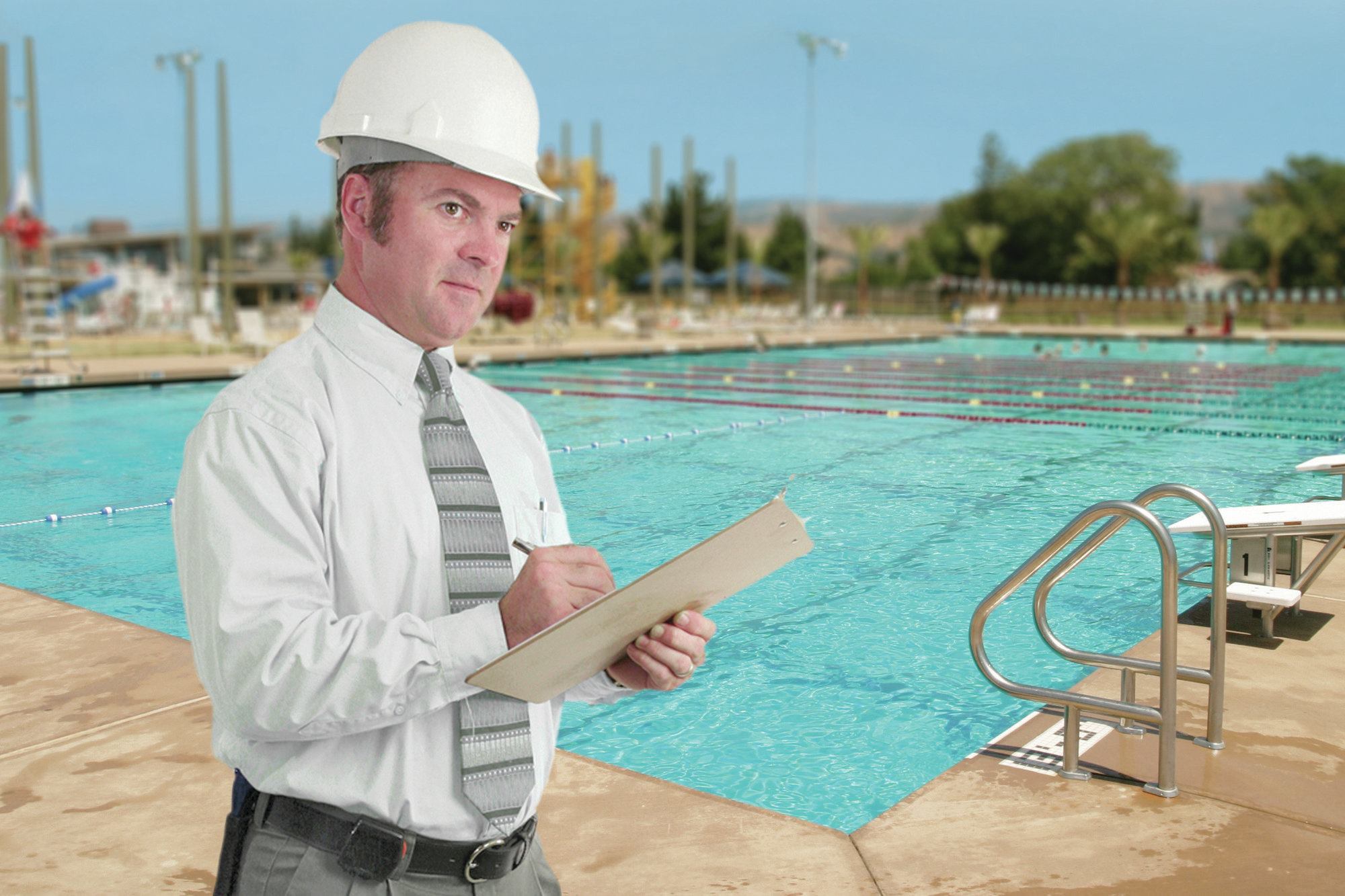Inspectors and Safety
The relationship between pool professionals and government officials has evolved post-Virginia Graeme Baker. Here’s what this means for the industry. | By Rebecca Robledo


Last year, a non-fatal entrapment occurred in a Nashville-area aquatic facility. While the operators there claimed the pool was compliant with the Virginia Graeme Baker Pool and Spa Safety Act and had an SVRS in place, some looked at published photos of the device and saw a problem. They believed it had been disabled or not installed properly.
Some industry professionals have long been concerned about the false tripping that happens with safety vacuum release systems. The job of these devices is to prevent entrapments, and in order to do that, they must detect pressure changes in the plumbing and, when that occurs, break the vacuum or shut off the pump.
However, many pressure changes can occur without there being an entrapment. Differentials can take place when in-floor pool cleaners switch zones or even when the circulation system first turns on. And some SVRS’s trip from pressure drops as little as 2 inches of vacuum in order to be on the safe side.
Because of this, some venues have installed SVRS’s to meet code but then bypass or disconnect them once they’ve passed inspection. Service professional Javier Payan has seen at least one such instance. An industry friend was staying at a hotel, and they decided to check the drain covers and pump room. In addition to degraded drain covers, the two SVRS’s had been bypassed. “We looked at them, took another look and said, ‘Are you kidding me?’ One’s bypassed and you look at the other one and go, ‘Holy smoke! The other one’s bypassed. What is going on around here?’”
When the professionals warned the pool operator, they were met with an icy reception. So they warned the local health department.
Steve Barnes, chairman of the APSP Technical Committee, also hears about bypassed SVRS’s and other misuses. “You hear about the SVRS sitting on the ground next to the pump,” said Barnes, who is also the product manager, safety and compliance with Pentair Aquatic Systems in Sanford, N.C. “In Tucson, they would rent them out for inspection.”
Payan worries about whether or not inspectors can always tell when an SVRS has been bypassed. “Depending on their experience level, an inspector could see these units and say, ‘Oh, you’ve got these units in here. They look fine,’” he says.
For Sacramento County, Calif., health officials, disabled SVRS’s have become another thing on the list for inspectors to watch out for. “We’ve seen some units when you open the box, there are no guts anymore — it’s just wires spliced together,” says Colleen Maitoza, supervising environmental specialist for the Sacramento County Environmental Management Department. “We have seen that, where they’ve been disabled or alarmed off and not functioning. If we find that on a single-suction system, it’s a closure.”
When pool professionals travel, even on vacation, they can’t help taking a little bit of work along.
“I always look at hotel pools when I travel,” says Steve Barnes, chairman of APSP’s Technical Committee and product manager, safety and compliance with Pentair Aquatic Systems in Sanford, N.C. “I see many that do not comply to the letter of the law because of the way the drain cover was installed or maintained. … If they didn’t have proper drain covers, who knows what kind of hazards really lurked? That told me the pool had not been evaluated, so those dual drains might be two separate single-drain systems.”
These professionals are realistic — they know that a lot of these pools are cared for by individuals who function as jacks-of-all-trades on the property, maintaining not only the pools but just about everything else on the site. But these instances also raise questions about the people who are supposed to be offering oversight to keep the public safe.
“Other [pools] clearly have been retrofitted, but the new covers weren’t installed [correctly] — they drilled additional holes through the cover … so that doesn’t technically comply,” Barnes says. “It just wasn’t done right by somebody, yet it passed inspection.”
As requirements for pools and spas increase in number and intensity, the relationship between the industry and government officials becomes all the more interdependent. Building and health inspectors play a larger role than ever in ensuring safety, particularly in the commercial market.
Industry professionals have their concerns about the ability of government officials to ensure the safety of pools and spas, especially given some of the challenges that inspectors and permitting officials must face. But parts of the industry have forged a tighter relationship with the government agencies and report improvements.Facing challenges
Today’s officials face a tougher job than their predecessors.
For starters, the level of knowledge that’s needed to monitor pools and spas for code compliance has increased exponentially. In the past, just checking the chemistry and finding out a pool’s turnover rate might be sufficient, but now details such as flow and velocity rates going through the drain need to be understood as well.
“Before they go do an inspection, they need to go into our imaging documents and look at the VGB paperwork to see what kind of covers are supposed to be out there, when they were installed, and make sure it’s approved,” says Colleen Maitoza, supervising environmental specialist for the Sacramento County Environmental Management Department. “Then when they go out, they reverify that information, make sure [the facility] hasn’t done anything … that’s different, like maybe they put in a bigger pump so there’s a bigger flow.”
Additionally, officials must know one drain cover from the next and make sure the screws are in place, whereas in the past they just would need to make a quick visual check that a cover was there, she says.
And like everyone else, health and building officials have had to face their share of budget cuts, requiring some to operate with skeleton crews.
In California, Sacramento County has been luckier than some, because it has only lost a few positions the last few years, Maitoza says. But to get all the county’s 2,200 bodies of water inspected between May and August, officials must work overtime. “We did some Saturday inspections,” she says.
This has some industry professionals particularly concerned about how existing pools are being monitored. New-pool plans seem to receive the oversight they need, with at least two officials — one each from the health and building departments — signing off. But checking the operation of existing pools takes more time per visit and is sometimes completed by less-experienced staff.
Additionally, most inspectors monitor many disparate types of operations, including restaurants, medical waste and waste water facilities. This leaves professionals wondering just how high a priority pools and spas will take. “What would you make more important — the fact that people go to a fair and are getting hot dogs and hamburgers that aren’t being cooked right, or water in a public swimming pool?” asks Paulette Pitrak, deputy executive director for the Northeast Spa and Pool Association.
Some worry that these factors mean officials are stretched too thin to acquire enough in-depth knowledge about pools and spas. It’s true that many health departments have tried to make the process easier to remember by establishing methods for conducting the inspections, but how do these officials respond to unusual projects, some wonder.
“I think that if they had people who were just focused on swimming pools and did more training, they’d be in a better position to have expert status,” says Javier Payan, president of Payan Pool Service in El Cajon, Calif. “I just don’t believe that you can have that level of understanding about pools and spas without really understanding hydraulics, flow rates, etc.”
Additionally, there is the question of experience. On the one side are seasoned inspectors who could hold their own in just about any conversation with a pool and spa professional, and even teach pros a thing or two.
But on the other end of the spectrum are new inspectors or those hired as seasonal help during the summer. These college students or recent graduates may have the intelligence, but haven’t logged in much time. “They may not have a lot of experience understanding hydraulics, engineering, chemistry and microbiology to really look beyond what it’s asking for on the inspection report,” says Thomas Lachocki, CEO of the National Swimming Pool Foundation in Colorado Springs, Colo.
While the increasing emphasis on pool and spa safety no doubt presented a challenge for the industry and government officials, it also has created an opportunity for both sides to use each other as resources.
Pools have become more important to many local health departments. “Earlier in my career, pools [were] more a stepchild to the food program,” Maitoza says. “It’s especially with the VGB issues that it’s become more of a priority.”
Part of the credit goes to courses that organizations such as NESPA and the NSPF have held specifically for inspectors, many funded by federal grants awarded from the Consumer Product Safety Commission as part of its VGB responsibilities.
NESPA has taught approximately 2,500 government officials in the Northeast so far. These inspectors had certain incentives to attend — NESPA arranged to have its classes approved as a source of continuing education credits to help inspectors meet their requirements, and a well-publicized child entrapment death put officials on alert.
“All the code officials showed up at the meetings, because they needed to understand what went wrong there,” Pitrak said. “So they were probably the leaders in terms of taking initiative to find out more about swimming pools.”
One chapter of that organization, the Connecticut Spa and Pool Association, began reaching out to inspectors even earlier. That state has had probably the most trying time with entrapment prevention laws. In 2004, the state began requiring safety vacuum release systems on all new pools, residential included. Three years later, a child died after he became entrapped, raising questions about, among other things, why the city approved the pool without the needed SVRS, when it was built after the mandate was instituted.
In response, CONSPA began to hold what it calls Inspectors Nights, in which health officials visit the group. This presents an opportunity for the industry and officials to ask questions and learn from each other.
Another group, NSPF, reports educating hundreds of health officials. Lachocki said approximately 500 officials took its Certified Pool Operator course in 2012, 800 underwent the Certified Pool and Spa Inspector Training Program, and 800 attended a course on preventing recreational water illnesses, with the majority being environmental health officials.
As Pitrak and Lachocki describe, it isn’t that every health official in a county can take advantage of these opportunities. Instead, health departments generally send higher-ups, who then train their charges. To encourage more widespread attendance, NSPF offers some of its courses via the Internet at a lower price.
Those classes and other efforts to reach out to governing bodies have paid off, observers say.
Pitrak, who conducted the courses, would begin with quizzes, asking questions like the difference between flow rates, water velocity and volume and how those affect suction entrapment. “We did a pretest and a post-test on some of the groups,” she said. “They all scored better on the post-test.”
Experts link a health department’s continuing education about pools and spas to its proficiency at inspecting aquatic facilities. They report regional patterns — inspectors seem to make the right calls in the Sun Belt states and the Northeast, where there are a lot of pools and more education takes place.
“There are certainly pockets of excellence surrounded by pockets of less than excellence,” Lachocki says. “There are many states that are very diligent about helping pools be safer, and others where it’s just not as important. Some of that is dependent on climate, but some is based on education and engagement of people leading the environmental health in those states or counties.”
Education aside, VGB has created a situation where everyone must collaborate, and some are seeing the benefits. “When VGB first came out, I think there was a lot of friction, and most of that was because of lack of knowledge on the part of both officials and [the] industry,” says Steve Dunn, vice president of Commercial Pool Systems Inc., a distributor in Martinez, Calif. “But over time both parties have become more educated and been able to understand each other’s positions and be able to perform the work correctly. Not that all work is performed correctly.”


